Niki Lauda: "The only one who should beat me was James Hunt because I liked the guy"
Niki Lauda and James Hunt remained good friends amid the drama of 1976, as their accounts to our editor-in-chief recall. As we discover, Hunt’s story in particular diverts on occasion from the memories of his own team manager
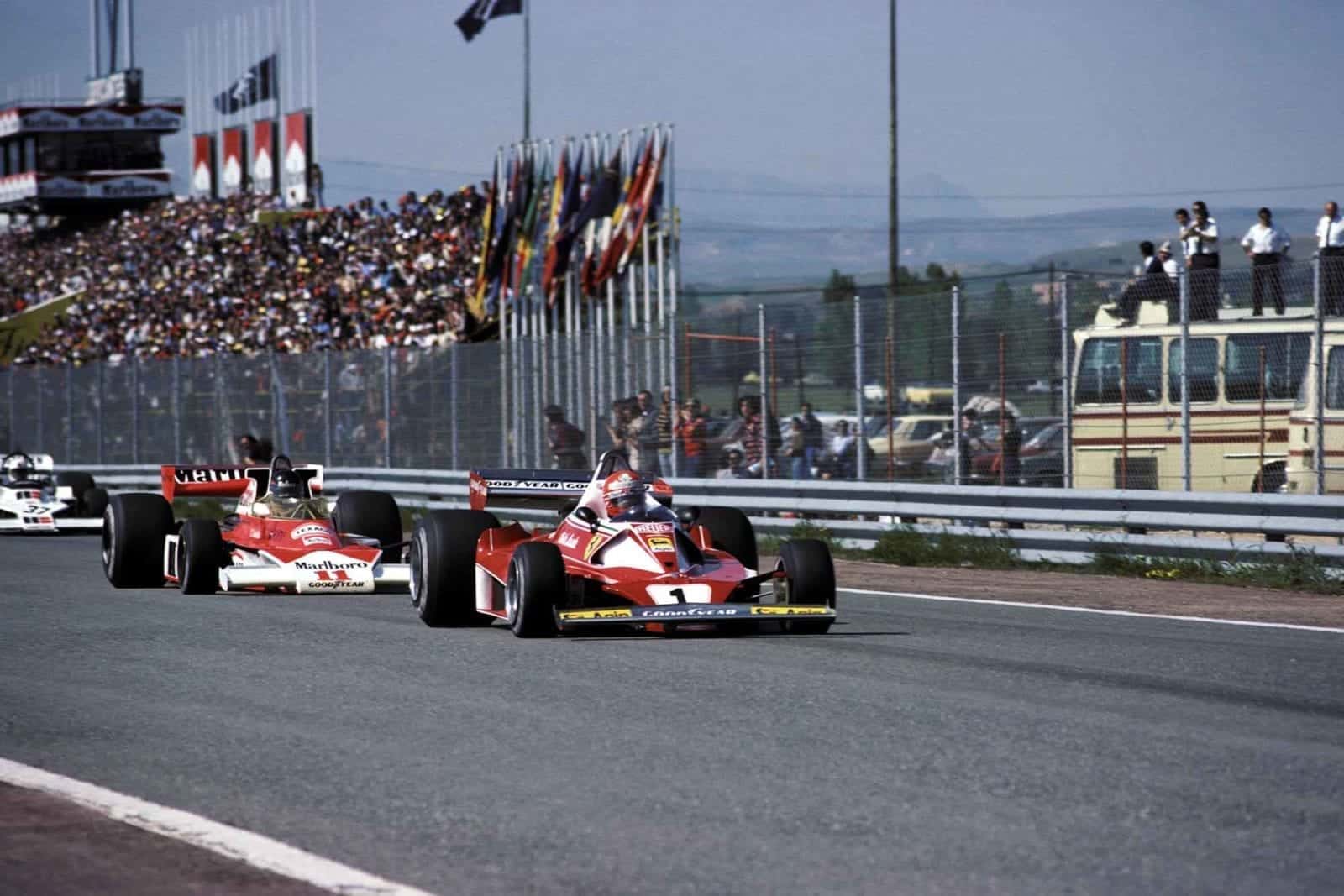
Hunt in pursuit of Lauda at the 1976 Spanish GP
Motorsport Images
When Alain Prost deemed unacceptable the conditions at Adelaide in 1989, and withdrew after one lap, he was widely criticised. However dead the reckoning, some said, a real racing driver just got on with it, and one or two even murmured that Prost was a coward.
Alain was unconcerned. “I know what can happen when you can’t see – Didier Pironi went over the top of me at Hockenheim [in ’82] – and in Adelaide I knew that stopping might cost me the World Championship, but I didn’t care. Niki had done the same at Fuji…”
So he had. Early in the 1976 Japanese Grand Prix, run in similarly appalling conditions, Lauda, along with Emerson Fittipaldi, Carlos Pace and Larry Perkins, withdrew. When Mauro Forghieri suggested an engine problem to spare his blushes, Niki would hear nothing of it: if he were thought a coward, so be it. And extraordinarily, in light of what he had lately been through, there were those who dared to use that word.
This, however, is to begin at the end of a season as tumultuous as any the sport has known, and in the context of today – when heavy rain means safety cars and even red flags – such events are difficult to take in. Fuji was the final act of a mesmeric drama.
Lauda had won the World Championship in 1975, and was consummately the favourite for ’76, with McLaren’s Emerson Fittipaldi again likely to be his main rival. In the meantime Hunt – in the wake of Alexander Hesketh’s withdrawal from racing – was without a drive.
Come November, though, Emerson made the unfathomable decision to leave McLaren for the family firm, and James was handed a lifeline. “Fortunately for me,” James remembered, “he decided to go Brazilian, whereupon John Hogan [of Marlboro] pitched me into McLaren straight away.
“We went twice to Silverstone, but both times it was wet, so it was only at Interlagos in January that I drove the car in anger. On the Saturday morning we had an engine blow-up, so I got out in the final session with about 20 minutes left: my first flying lap was my first pole, which I was rather pleased about…”
That rather set the tone for the early season. In the race Hunt couldn’t quite live with Lauda, but he ran second until a jammed throttle put him off the road. At Kyalami James again beat Niki to pole, but on race day the Ferrari led throughout, the McLaren a second behind.
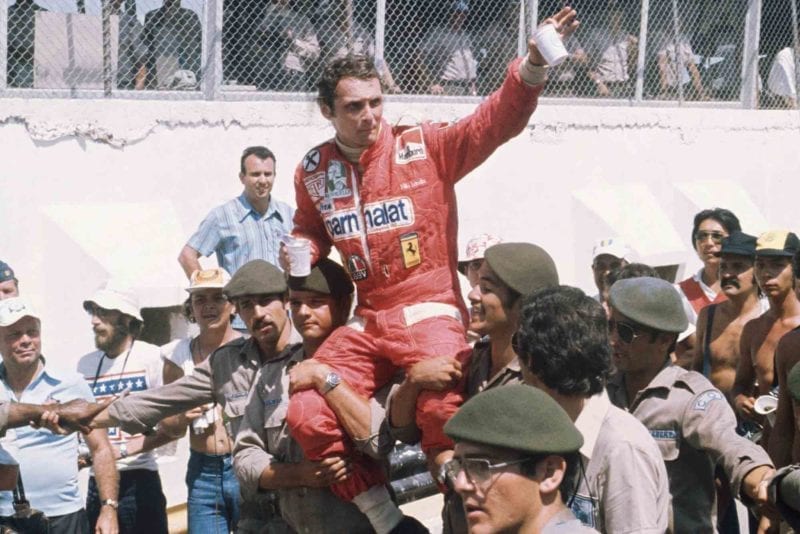
Lauda celebrates victory in Brazil, 1976
Motorsport Images
At Long Beach no one could get near Clay Regazzoni, but Lauda made it a Ferrari 1-2, and now had 24 points, Hunt a mere six.
On the second lap James had a coming-together with Patrick Depailler, and clouted the wall. Seemingly unaware that his car was barely damaged, James stood on the track, shaking his fist at the Frenchman: “It wasn’t my shining hour. If I’d carried on and got a new nose, I’d probably have scored some points…”
So to Jarama, and a few days beforehand Lauda had an accident – on a tractor – that could have killed him.
“I overturned the thing, and it was lucky I only broke three ribs. Hunt was on pole, but I led half the race until he overtook me – I didn’t see him coming, had to pull left to avoid him, and then I had a pain like you cannot believe, and afterwards had to go to the hospital…”
“Lauda had an accident – on a tractor – that could have killed him”
Hunt-Lauda was how they finished, but James was then disqualified. “There had been some regulation changes, to do with overall restrictions on a car’s width and length,” Hunt recalled. “The dimensions had been decided by measuring the cars the previous season, and that should have presented no problem to us because the McLaren was the widest car, and had defined the limit.
“The problem was that McLaren – in a fantastically sloppy performance – assumed the width of their car would be OK, and didn’t bother to check it. By now, though, we were using slightly different tyres, with a bigger bulge – and that’s the widest point on the car. It was three-eighths of an inch too wide or something…”
On appeal Hunt was reinstated as winner of the Spanish Grand Prix, but that was much later in the season, and in the meantime McLaren modified the M23, in order to narrow it by the requisite amount. The effect on its competitiveness was disastrous.
“Rather unnecessarily,” said James, “they moved radiators around, and so on, which destroyed the performance of the rear wing. I said, ‘Look, it’s not reducing the rear track by three-eighths of an inch that’s screwing the car up – something has fundamentally changed. Why don’t we put it back to how it was in Spain – except within the width limit?’
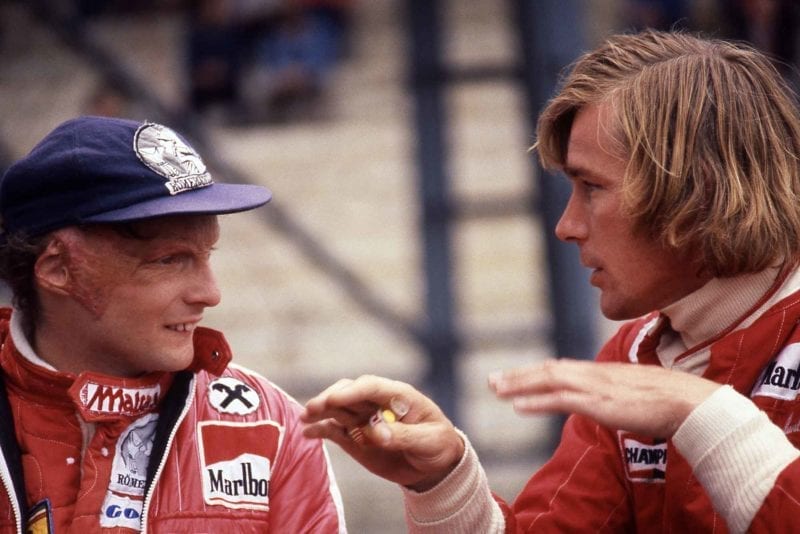
The rivals’ off-track friendship was tested during ’76
Motorsport Images
“I always had a problem persuading McLaren to do anything, and it took me until the French Grand Prix – after the first day – to get that done. Overnight they changed the car back – and on Saturday I was on pole! By then, though, we’d effectively lost Zolder, Monte Carlo and Anderstorp – Niki was winning, and we were off the pace.”
Lauda indeed won in Belgium and Monaco, and finished third – behind the Tyrrell six-wheelers – in Sweden. By now he was on 52 points, to Hunt’s 17.
James won at Ricard, though, after the Ferraris blew up, and as Brands Hatch loomed Hunt Mania – it was nothing less – was rife in the land. He made an indifferent start, however, and when the Ferraris tangled at the first corner, his McLaren was launched over Regazzoni’s car, breaking its front suspension when it landed. The race – most unusually in those days – was red-flagged, and Hunt headed for the spare car.
“Then,” James said, “it was announced that I couldn’t use the spare, at which point the crowd started to throw things on the track!
The stewards hadn’t really decided what to do, but the organisers concluded that the only way to avoid a riot was to let me start, whatever happened! By then my race car was repaired…
“Soon after half-distance I passed Niki into Druids, and won, at which point – surprise, surprise! – Ferrari, stalwarts of the sport, protested…” Three months later the matter would resurface; by then, though, much had changed.
At the Nürburgring Hunt won, and Lauda crashed. To this day Niki has no memory of the accident, which occurred at Bergwerk, easily flat for an average driver.
As the race restarted, reports of Lauda’s condition seemed encouraging. “The news was that he was talking,” said Hunt, “and had only minor burns, so one was able to get back into the car without any real concerns…” I remember, though, talking to Chris Amon: “There’s no way,” he said, “that Niki has light injuries. He was in that car for a hell of a time…”
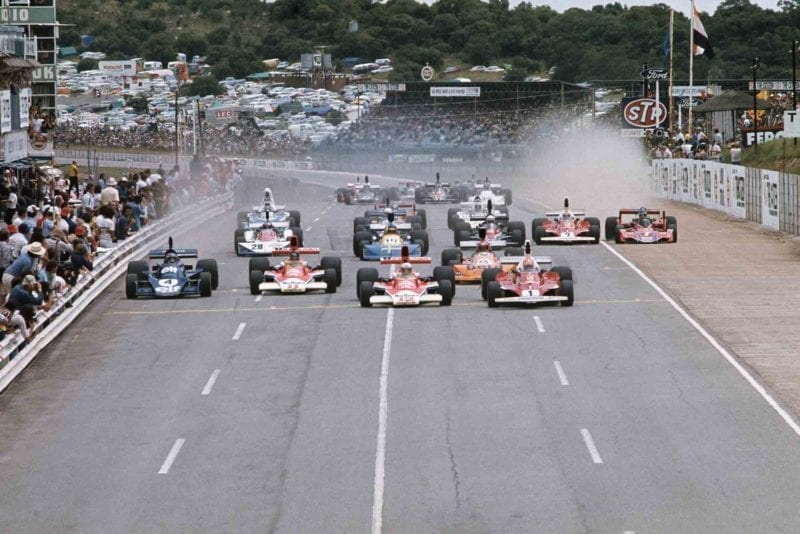
Lauda leads Jochen Mass at the start in South Africa, 1976
Motorsport Images
So he had been, and had it not been for fellow drivers who braved the fire and got him out he would have died right there. As it was, his life was jeopardised not by burns, but by the inhalation of toxic fumes, and soon the gravity of his condition became clear.
“The priest gave me the Last Rites and then left without speaking” Niki Lauda
“I was asked,” said Lauda, “if I wanted the Last Rites, and I nodded – I couldn’t talk or see. The priest came, gave me the Last Rites – and then left, without speaking to me. I’d expected him to say, ‘God will help you’ or something, so that really annoyed me, and I said to myself, ‘Now I’m really going to fight for my life…’ With a lung problem like I had, you live or you die – and if you don’t die, you recover quickly.”
And recover quickly is what Niki did. Within days he was convalescing at home, already planning his return to racing. When Monza was mentioned, it seemed scarcely believable, but the fact is that when Lauda started practice in Italy a mere 39 days had passed since he had been dragged from his car at the ’Ring.
In the meantime two Grands Prix had been run, at the Österreichring (despite Ferrari’s efforts to have the race called off, ‘in honour’ of Lauda), and Zandvoort. John Watson won the first, scoring Penske’s only F1 victory, and Hunt the second, chased by Regazzoni.
Now James was within striking distance of Lauda’s points lead, but at Monza he came to understand that other parties had a role to play in this championship. On Saturday afternoon, following a ‘fuel check’, McLaren was informed that its times in final qualifying were to be disallowed – quite a blow, given that this had been the only dry session.
Hunt, as ever, was robust in his response: “The Monza authorities cheated, as simple as that. According to the rules, you were allowed up to 101 octane, plus an error of one octane. They announced my fuel as 101.7 – still legal, by the rulebook – but as it later turned out, it wasn’t even 101! We appealed, of course, but the organisers knew it could only be sorted out after the race had been run…”
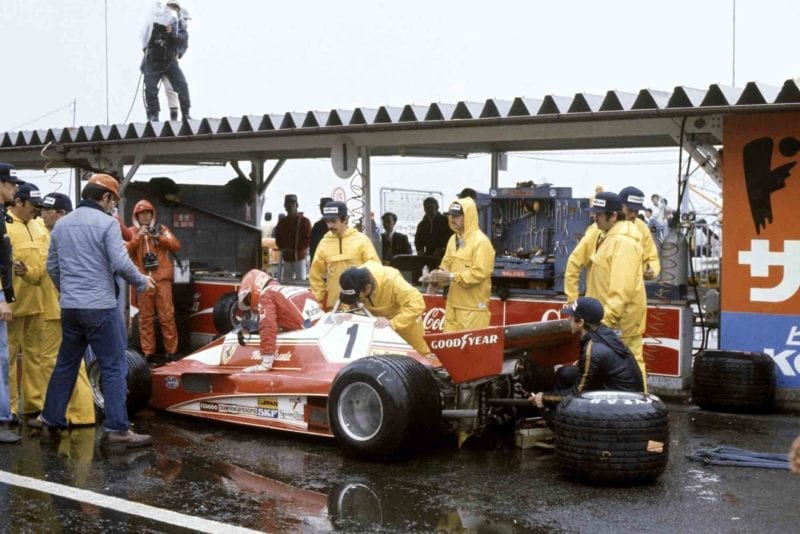
Pivotal moment at Fuji: Lauda parks his Ferrari after deciding conditions are too dangerous
Motorsport Images
Starting from the back, Hunt tangled with Tom Pryce’s Shadow, while Lauda finished a remarkable fourth in a race won by Ronnie Peterson. Afterwards I looked on as he removed his helmet – extra-large to accommodate the bandaging – and peeled off his balaclava, stuck to his face by dried blood from fresh wounds.
The fundamental premise of Rush is that Hunt and Lauda hated each other, but while there was powerful antagonism between their teams Niki and James, who had known each other since their F3 days, were always friends.
Save for a few hours in Canada, anyway. “On the Tuesday before Mosport,” said Hunt, “I was informed that I’d been disqualified from Brands Hatch. None of us had taken Ferrari’s protest seriously, because there were no grounds to suggest it might succeed, and as a result McLaren, led by Teddy Mayer, didn’t prepare any proper defence. It was a supreme shock to me – although of course it had been a pleasant surprise to be reinstated in Spain.
“When I got to the circuit, the press were winding it up, going to Niki and saying, ‘James said this’, then coming to me, and saying, ‘Niki said that…’ For a few hours we hated each other, but on Friday we talked it through, got in our cars and life carried on as usual…”
Hunt won the race, then did the same a week later, at Watkins Glen, and while many believed he was spurred by anger, the opposite was true. “Anger dissipates in me very fast, and what helped my driving in those races was actually a lack of pressure: with the Brands points gone, the championship seemed over, so I was completely relaxed and driving very, very well.
“It was funny, that weekend at the Glen. Niki and I had adjoining rooms in the hotel, with a connecting door. Early on race morning he came stomping over to my bed, already in his overalls, and announced, ‘Today I vill vin ze Vorld Championship!’ Whether he was being funny or trying to psyche me out, I don’t know, but I just dissolved into helpless laughter…”
One race to go: Fuji, where we came in. Lauda on 68 points, Hunt 65. After endless debate about the flooded track, the race started an hour and a half late, and while James led away, Niki, as we said, swiftly withdrew.
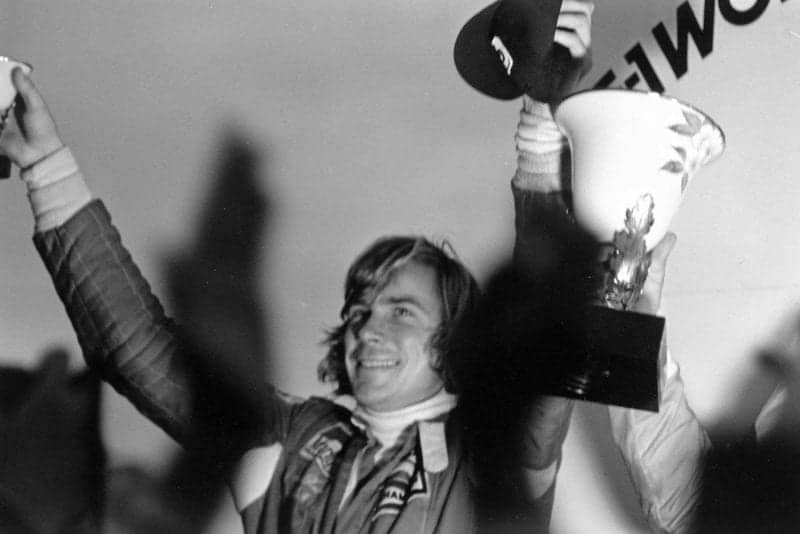
Hunt celebrates clinching the 1976 World Championship
Motorsport Images
“I stopped because of the conditions – nothing to do with after-effects from the accident. Half an hour later the rain stopped, and if I’d stayed in the race it would have been easy to get the points I needed, but I know that – for me – I did the right thing…” Even with Lauda out, Hunt still needed four points – third place – to win the title. “With the track starting to dry, I knew there would be tyre problems eventually, and I started asking McLaren – with hand signals, because we didn’t have radios in those days – what to do. Their response was to hang out a board with a big question mark on it! So that was very helpful…
“When I did come in, I’d already got a slow puncture and then I had a blown front.
The boys had to lift the front of the car so they could slip the jack under, and it was a very long stop. All I could do was shut my eyes, floor it, and pass as many cars as I could. At the end they told me I was third, but, given McLaren’s record, I didn’t immediately believe it.
“I could tell by his face that I hadn’t won, but I didn’t mind” Niki Lauda
“After the podium I went to the press room – it was within an hour of the finish, so protests were still possible – but when I came out I knew nothing could take it away from me because everybody had gone!”
Lauda, meantime, was at the airport, where he met the local Ferrari importer. “I could tell by his face that I hadn’t won, but I didn’t mind, actually – the only one who should beat me was James, because I liked the guy. All the differences between McLaren and Ferrari never made any difference to us personally.”
When I think back to that year, I recall a moment when Lauda was being interviewed by a remarkably insensitive American news magazine journalist. “Isn’t it a problem for you,” she asked, “facing the world, the way you look now?” “For me, no,” said Niki. “For you maybe it’s a problem – you can see me…”
And I remember, too, a tongue-in-cheek remark made by James – ever the public schoolboy – on the Parkinson show early in the year: “We’ve got quite a few foreigners winning races at the moment – won’t do, will it?”
His best drive, he told me, was at Anderstorp, where he finished fifth, his McLaren off the pace. “A poor result, but crucial, because I got two points – and won the title by one…”
